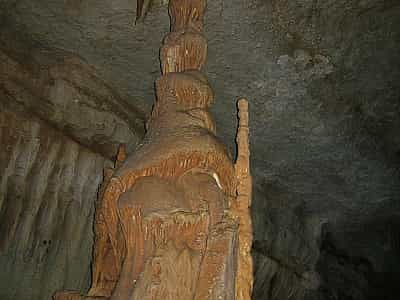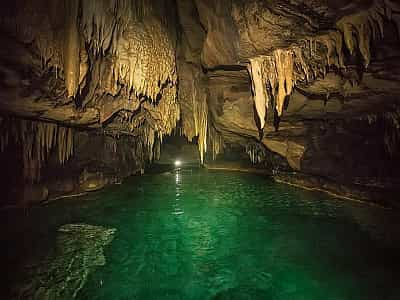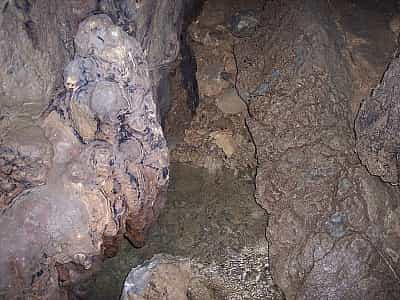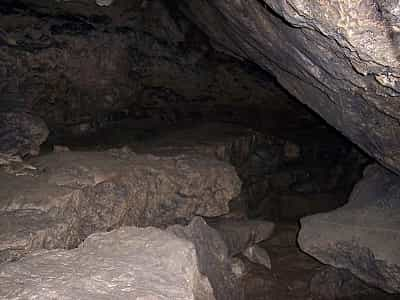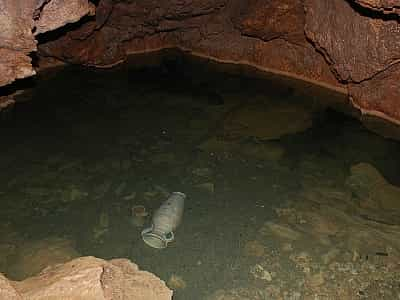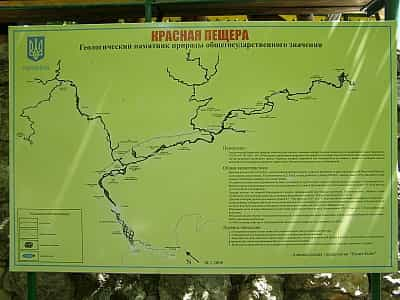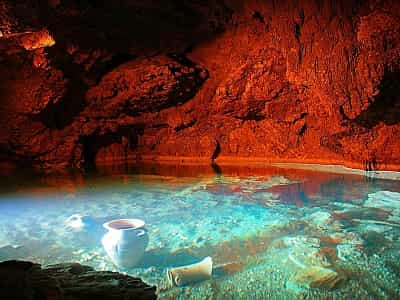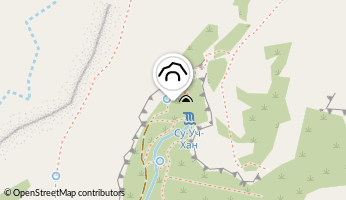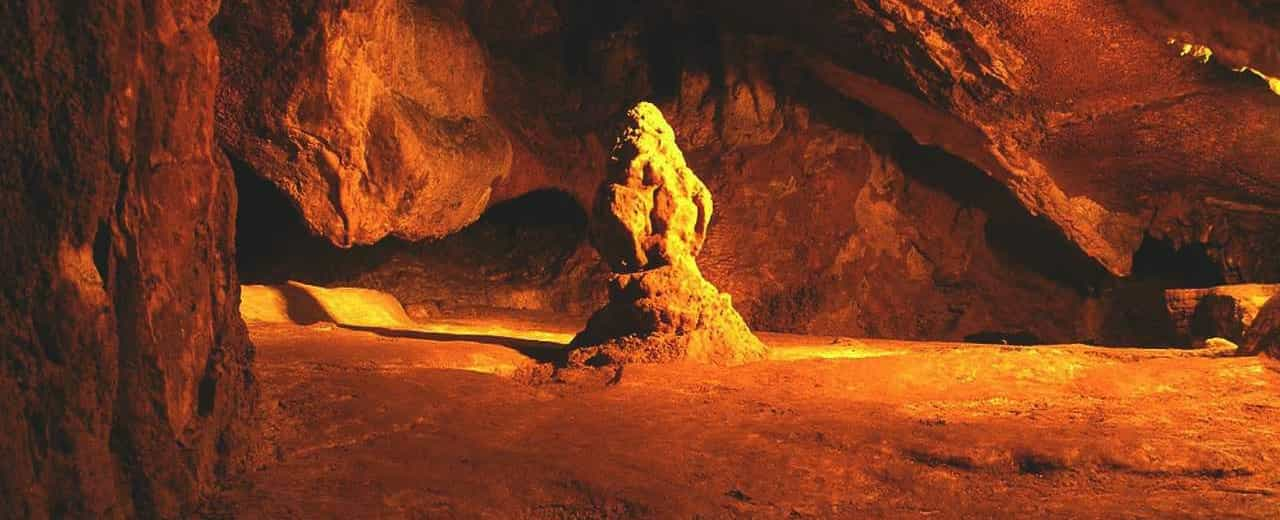
Kyzyl-Koba
Show table of contents
It is the largest cave object in Crimea. Actually, it is the result of karst formation. The cave is named «Kyzyl-Koba» or it is also called the Red Cave. It has no analogues in Eastern Europe in terms of its size. The age of the location is more than 2.5 million years. The cave is located on the slope of Dolhorukivska Yaila, near the village of Perevalne.
Description of the Red Caves
The object is better known under the name Kyzyl-Koba. Translated from the Crimean Tatar language means "red cave". This name is recognizable in the tourist environment. The location has a bright red color of vertical surfaces. This is explained by the presence of a large amount of iron oxide in the structure of rocks. The size of the object is impressive. The total length of the cave passages is about 21,000 meters (we are talking about the part that has been explored). The total area of Kyzyl-Koba reaches 60,000 square meters. The formation includes 6 levels, with the last "floor" located at an altitude of 275 meters.
Rivers flow in Kyzyl-Koba, thanks to which the next karst locations are washed away. The most famous river is the «Kizilkobinka». This river feeds the famous Su-Uchhan waterfall. Separately, it is worth dwelling on baths and lakes of underground origin, attracting attention with their clean water, where it is quite possible to find cave pearls. It is difficult not to notice stalagmite and stalactite formations inside the object. We should add that the Kyzyl-Koba is truly considered an archaeological monument, because various ornaments, tools, bronze products and much more were found on its territory.
Video from the Kizil-Koba cave
History of discovery
The first settlements around the Red Cave appeared during the Paleolithic era, more than 70,000 years ago. Even in the 20th century, a sanctuary was found at the entrance, the date of construction of which falls on the VII-VI centuries BC. The location became the object of the construction of priests' half dugout, pits for ritual grain. In the Red Cave during ancient times, domestic animals were sacrificed, the remains of which were preserved in one of the halls. In 1960, archaeologists discovered the entrance to the cache from the 12th-13th century, in which they found a riding kit, a leather saddle, a dagger, etc. The beginning of the 21st century was marked by new finds in the form of iron arrowheads.
During the Middle Ages, the extraction of black refractory clay was conducted in the Red Cave, which was used in the manufacture of smoking pipes. The first mention of the location in literary sources falls on 1803 (P. I. Sumarokov wrote about it). This is when the cave became a tourist attraction. It is noted that in 1825 the cave was visited by A. S. Hryboidov. Since 1990, the cave has been equipped with about a 500-meter area suitable for the reception of organized tourist groups. Efforts to improve routes and improve the territory have not stopped to this day.
Morphometric indicators
In total, there are 6 floors in the Red Cave. The height between the levels starts from 410 cm. The surveyed part of the Kyzyl-Koba is about 26,000 meters as of 2017, and the volume is 270 thousand m3. The depth of the formation reaches 135 meters. In summer, the average air temperature inside the cave is just over 9 degrees, in winter - 12 degrees above zero. The largest halls (including Chinese and Indian) reach up to 40 meters in height, 25 meters in width and extend in the longitudinal direction for several hundred meters.
Cave Galleries
The air temperature inside the underground passages is no more than 10 degrees, so it is recommended to take warm clothes with you. The first gallery at the entrance on the second floor leads to a large hall, from where the observation of galleries and tunnels begins. Throughout the entire tourist route has lighting, and the most interesting expositions have additional illumination. Following the right side, you can reach the Archaeological Ring on the third floor. As the path will run through a small lake, it is advisable to take special shoes with you.
Getting to the place of the tectonic split of limestone formations, it will be possible to find a separate convenient entrance to the reservoirs on the ground floor. Then begins the Hryboidoivska gallery, which feels fresh air and cleanliness. After a few minutes of traveling along the cave there is a five-meter well with a depth of 5 meters, which leads to the 1st floor. Just a little further away, attention is attracted by a low stalagmite in the form of a huge mushroom. Nearby there are sinter baths with a mud bottom and clean water. If you walk a few more meters forward, you will come across a cluster of stalactites, stalagmites and an old river. Actually, the usual tourist route ends here.
Back to the branch of the concrete path, it will be easy to notice the tunnel of artificial origin, which will allow you to get to the distant locations of the Red Cave. Previously, the entrance to the hall looked like a narrow half-meter gorge, which was expanded at the end of the last century. This made it possible to open an Indian hall with a characteristic reddish-brown color and a Chinese hall with unusual sinters. Some compare this miracle with the raised edges of the roof of Buddhist pagodas. Next comes the Academic Hall, gradually turning into an underwater gallery.
Interesting facts
In ancient times, an unexplored culture lived on the territory of Kyzyl-Koba to this day. This has been established that the local residents at that time had reached a sufficiently high level of their own development. This is confirmed by the found tools, household items, bronze artifacts, all kinds of jewelry. There exists a version that the people who inhabited the cave hid and desperately opposed the attacks of the ancient Scythians.
The Kyzyl-Koba Valley attracts the attention not only of tourists, but also of esotericists, UFO researchers. Experts say that the location has an unusually strong energy. In the dark, large lights appear in the air that do not look like stars and other heavenly bodies. Eyewitnesses claim that UFOs regularly "fly" near the caves. There is no official confirmation.
Visit conditions
Excursions to the Red Cave are held during this year, 7 days a week, from 9:00 to 19:00. It is possible to order an excursion along the extreme route. Warm clothes can be rented on site. Taking photos and videos in a "hand-held" way is free, but with a camera stand is prohibited.
Location
The landmark is the village of Perevalne, located in the Simferopol district. The easiest way to get here is by fixed-route transport «Simferopol- Perevalne». Departure from the central railway station is carried out every 20-30 minutes. An alternative way is a trolleybus connection, route No. 21, 51, 52 «Simferopol-Alushta», «Simferopol-Yalta». The final stop (from where it is easy to get to Kyzyl-Koba along the asphalt road to the parking lot near the Viking complex) is «Perevalne -2» or «Stadion» («Stadium»). On average, this will take about 20 minutes of time, during which about 1,500 meters of the path will be passed. Following the signs, it will be possible to go to the ascent, a wide lawn, a small bridge leading to a concrete staircase. The entrance to the territory of "Kyzyl-Koba" begins with it.
| Location coordinates | 44°52′12″ N 34°20′36″ E |
| Length of the cave | 26000 meters |
| Volume | m³ |
| Depth | 135 meters |
| The arrangement of the cave | for individual visit |
| Distance from the nearest settlement | 3 km |
